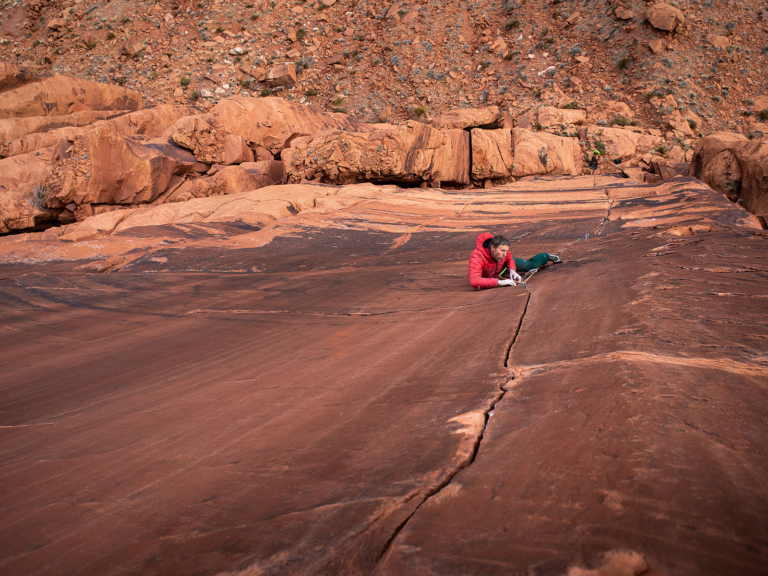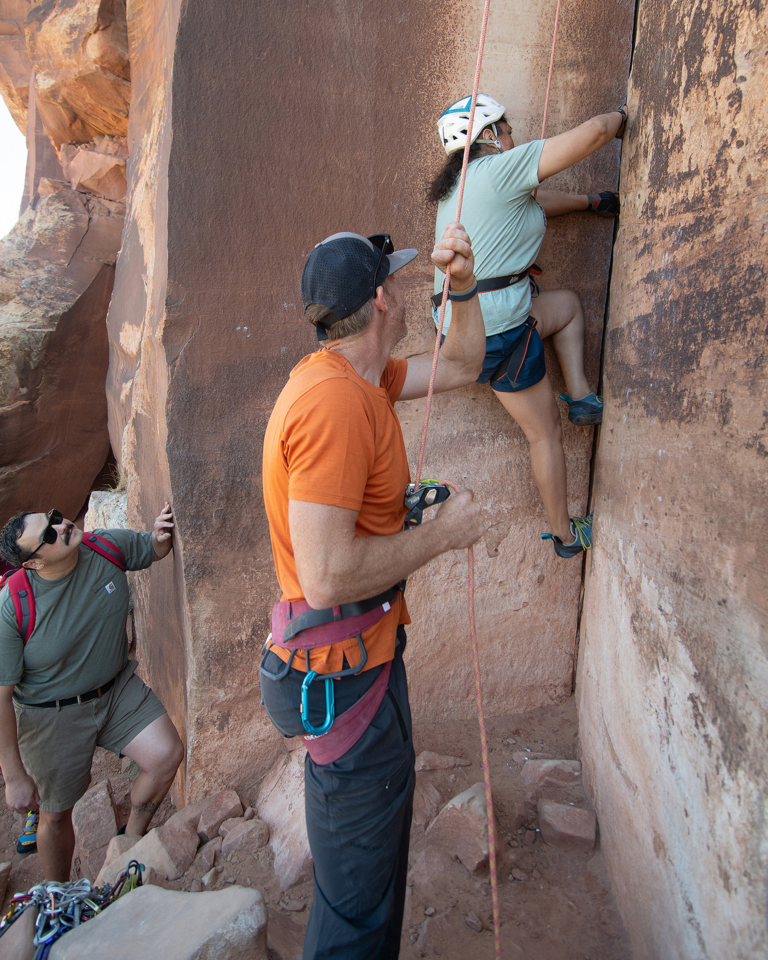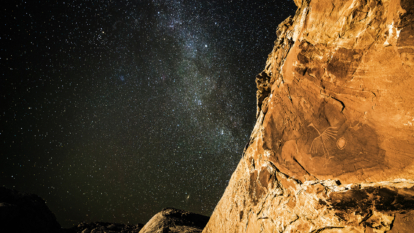Beneath the Rock
My first impression of Bears Ears was as a grubby 5-year-old. My family and I slept under the stars, cooked on backpacking stoves and climbed cliffs full of dust. The wind blew dirt into everything, dyeing our skin and hair a red tint. I felt close to the land because it lived in every nook and cranny.
I craved the desert in my teenage years and returned to Bears Ears every year to climb. It’s where I brought my friends, fell in love with my wife and dreamt about bringing our future babies. Back then, a week in high season meant you’d only see one or two other climbers around. Being there was a true escape from the stresses and hustle of everyday life. And I held pride in believing that the land belonged to us climbers.
During these visits to Bears Ears, I became more in tune with my love of climbing. I began to crave not only the physical nature of the sport but also the stillness, the beauty, the lack of external stimulation, where excitement and peacefulness coexisted. In this world, distractions dissipated. I felt closer than ever to my inner self and the people around me.
Then, the crowds came. And with them, a more visible erosion of the rock. Thousands of ascents wore down stripes of desert varnish from the most popular routes. Chalk and visually impactful anchors became commonplace; approach trails got worn in; and the dusty inside of the cracks were scrubbed clean.
My friends and I had always put effort into protecting the fragile rock, like avoiding the use of chalk, making sure not to walk on cryptobiotic soil and using fixed anchors only for rappelling. And I thought our impact was minimal. But now that Bears Ears was a popular climbing destination, I started to question the legacy we were leaving.
I finally confronted this doubt when I joined a coalition of climbers, conservation groups and tribal nations working to establish Bears Ears as a federally protected national monument under the Obama administration. This same coalition went on to protest the first Trump administration’s attempts to reduce the monument by 85 percent in 2017 and successfully advocated to restore the monument under the Biden administration. Over this decade of my life, I formed my first relationships with the original stewards of the land I had long loved. And I realized the story I had told myself—about the empty landscapes, the climbers who owned the land, the minimal impact we left and our closeness to the rock—was all wrong.

In 2017, the first Trump administration attempted to reduce Bears Ears National Monument by 85 percent. Tommy Caldwell climbs on land that had previously been protected, just months before the Biden administration restored it. March 2021. Bluff, Utah. Photo: Eliza Earle
In 2022, a group of women from five tribes connected to Bears Ears—known as the Women of Bears Ears—invited me to come pray. We met atop a cliff called the Moki Dugway. The morning had a wildness to it. The clouds were racing above, casting moving shadows in the expansive desert landscape. Nine women wrapped in blankets gathered in a circle, their hair whipping across their faces.
These women were in pain. A few weeks earlier, someone had put bolts through a petroglyph panel, mistaking the ancestral rock art for graffiti. Before that, cliff dwellings were robbed. And in 2021, a culturally significant rock near Moab, called the Birthing Rock, was desecrated with etched-in racist slurs and the words “white power.” It was unclear who committed these horrible acts—if it was climbers or newer user groups, like hikers, 4-wheelers or river rafters. But it was up to us climbers, a major user group of Bears Ears, to take some level of responsibility.
On the cliff, the women took turns praying in their Native languages. I couldn’t understand their words, but I felt the power and emotion. Suddenly, the land and people seemed to merge. I saw that these women are part of the land, and the land is in them. From their perspectives, trees and rocks are their relatives, not things to discover, dominate or destroy. In that moment, I realized the bond to the land I felt as a climber was nothing compared to theirs.
After the prayers, I spent the rest of the morning listening to their stories over breakfast. I knew some of the older stories from history lessons: the forced removal of their people from this land and decades of pot hunters and looters. But I also heard stories of other injustices that I was unaware of. Like how the local uranium mines had poisoned their groundwater, killed Elders and forced communities in the Navajo Nation to truck in water. Or how Bears Ears was once one of the most densely populated regions in the United States.
It’s embarrassing to say this now, but before this trip, I hadn’t considered that the artifacts I saw as a kid were part of a living, breathing society that still exists. Sure, I admired the petroglyphs and the cliff dwellings. I even came across pottery shards on a few occasions. But I attributed them to an ancient civilization no longer present. Just like I had attributed the harms of colonization to the past.
I started to question what stories I had accepted as truth. I had once thought my climbing impact was minimal. But now I wondered whether I was any better than the looters.

Tommy gives Bears Ears Inter-Tribal Coalition (BEITC) co-chair Davina Smith (Diné) a belay and some words of encouragement as BEITC staff member Ruben Pacheco looks on. Indian Creek. Photo: Don James
“Would you drill a hole in the body of your grandmother so you can climb her arm?” an Indigenous knowledge holder asked me during my latest trip to Bears Ears.
I was back on the land with a group of 20 tribal representatives from the Bears Ears Inter-Tribal Coalition—including elected officials, Traditional Knowledge Holders and tribal stewardship experts—to help inform a recreation plan for the new, historic collaborative management agreement between the federal government and the tribes who successfully advocated for the creation of Bears Ears National Monument. We ate together, had group discussions and even went climbing in Indian Creek.
The tribes of the Bears Ears Inter-Tribal Coalition don’t even have a word that translates to “recreation.” So, things can get muddy. To me, this word has a certain frivolous meaning. My biased feeling is that climbing can mean so much more: community, religion, connection with place and self. At their best, climbers strive to take care of the places they climb. So, I wanted to build trust with the caretakers of the land to understand what taking care of this place meant to them.
Climbing with the tribal members was fun. Several had climbed in the past; others gave it their best first try. Afterward, they shared their impressions of the day. Many felt like they understood the playful nature of climbing—the community vibe and camaraderie. They appreciated my willingness to share the thing I love with them. But they also wanted to share their concerns with the sport.
They questioned the bolts. They noticed the wear of the desert varnish and viewed it as an unfortunate scar on the landscape. One woman was distressed by the stories she had heard from her Elders who had to climb to safety during the violent military raids that displaced their families during “The Long Walk.”
I always thought my relationship with the lands I climbed on ran deep—my life often depends on this closeness. But spending time with the descendants of the early inhabitants of the Bears Ears region has taught me that building a road, a mine or even placing a climbing bolt into the rock is like a physical wound that brings pain to the people who are the land. Unless your cultural heritage depends on the land, you will never truly know this connection or this pain.
Accepting this truth has required a level of humility. For so long, I had predicated my identity, and my love for the sport, on my connection to the rock. And it’s not to say that connection does not exist. These connections are just different. And as I belayed an Elder up Indian Creek, I felt in my bones that they are not opposed to recreation, just deeply concerned for the well-being of the landscape and their non-human relatives within it.
Look at us desert climbers. We become so in tune with the nuances of rock texture, and we know different rock types. We develop an awareness for potential loose rock and breakable holds. We know how our feet fit into different size cracks and the different configurations of finger and hand jams. But our awareness is so specific to what’s directly within our path.
The tribal members I was with seem to have another kind of awareness for the greater landscape. Each of the five tribes has their own way to connect and show respect. On this latest trip, they prayed as they walked and spilled water from their bottles as an offering. I even saw one Elder tuck a leaf from a desert plant into their cheek and hold it there.
Rather than feel shame that I won’t ever connect to the landscape in this way, I feel joy in knowing there are so many layers to the rock that exist—so many relationships and lives these landscapes have known. My love for climbing, therefore, feels boundless and infinitely more expansive than a younger version of myself could have ever imagined.
There are still things I have yet to reconcile, like the ethical nature of bolting a rock. But as I’ve opened my mind to the reality that the land is living, that us climbers have no title over it and that it holds thousands of years of lessons, I’ve felt a bit closer to that mix of peacefulness and excitement that led me to fall in love with the sport to begin with. And I know that cultivating this more nuanced connection—and sitting in the humbling feeling of being a visitor on these lands—won’t just make me a better steward. But a better climber as well.
A Note from Patagonia and the Bears Ears Inter-Tribal Coalition: This personal reflection highlights the importance of listening to tribal nations and learning from Indigenous stewards. Each tribal nation holds distinct teachings, histories and relationships with the Bears Ears landscape. The five tribes of the Bears Ears Inter-Tribal Coalition—Hopi, Navajo, Ute Indian Tribe of the Uintah and Ouray Reservation, Ute Mountain Ute, and Zuni—bring unique cultural knowledge and stewardship practices to their work. We also acknowledge that many other tribal nations maintain deep ancestral and cultural connections to Bears Ears, beyond those currently participating in the Coalition. Understanding and protecting this sacred landscape requires honoring that diversity, respecting boundaries, centering Indigenous voices and sovereignty, and the courage to cultivate meaningful, dynamic relationships.
Visit with Respect
The five tribes of the Bears Ears Inter-Tribal Coalition ask that all visitors follow 20 tips to encourage responsible visitation and prevent degradation of the monument’s ecosystems and sacred sites.

